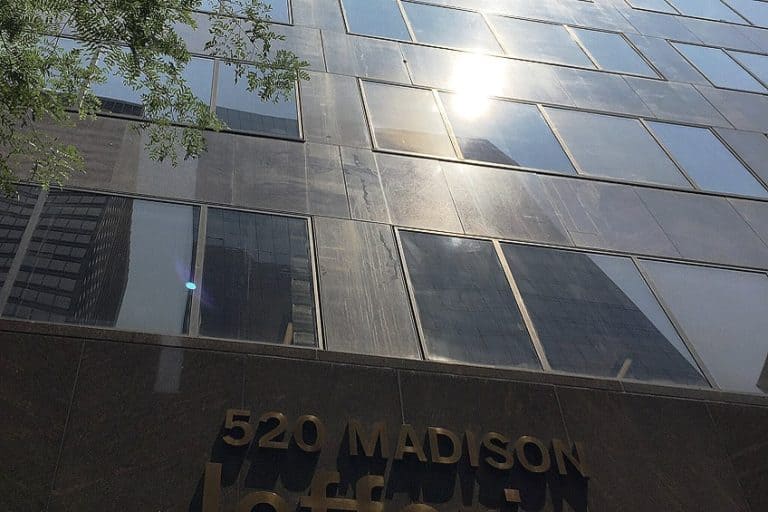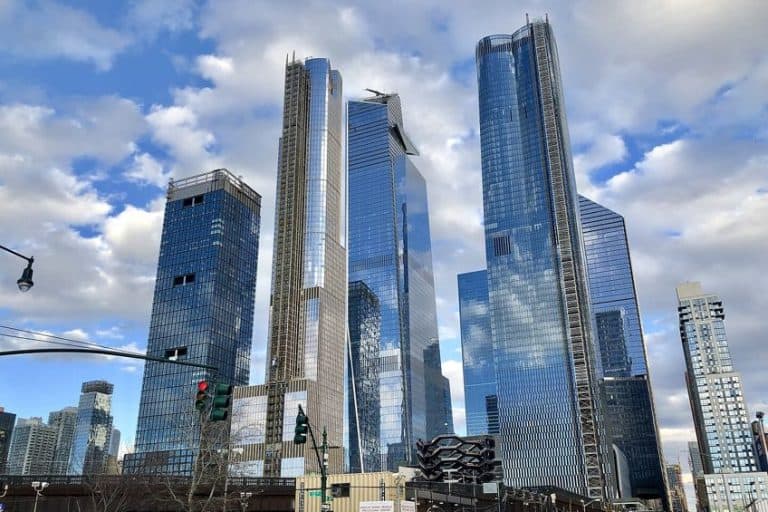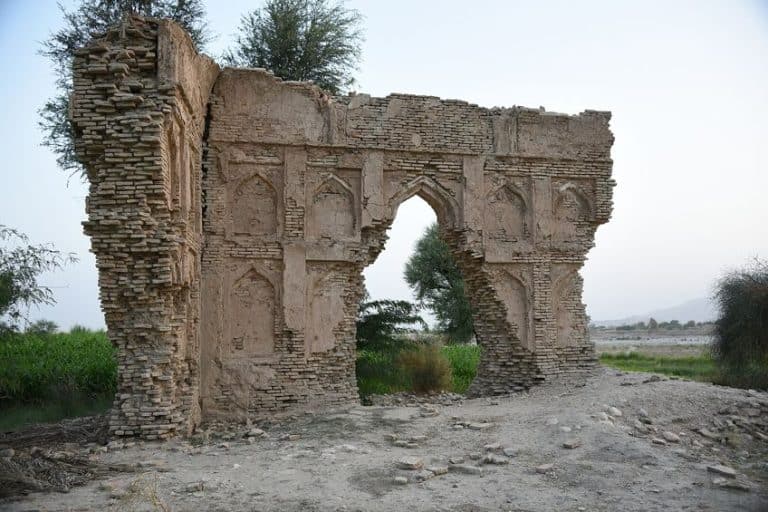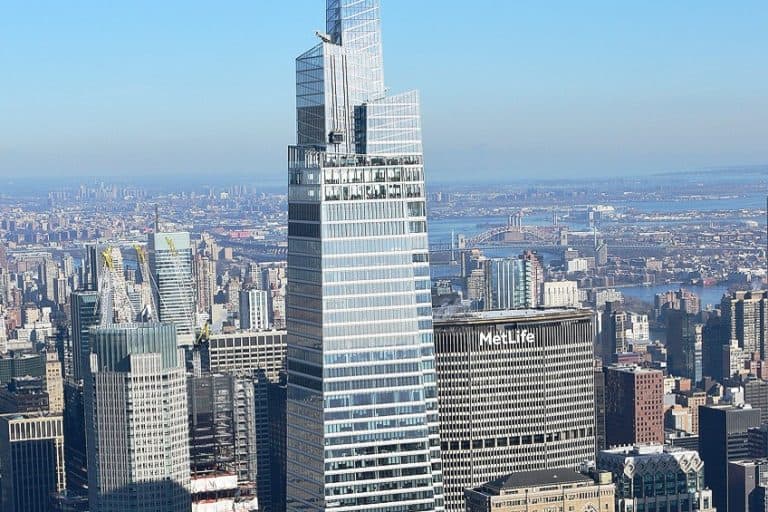Ajanta Caves – A Look at the Paintings in the Caves of Ajanta
The Ajanta Caves comprise 30 monuments cut from the rock by the Buddhists from around the 2nd century BCE up to approximately 480 CE. The interiors of the caves of Ajanta are adorned with artworks that are regarded as some of the best existing examples of Indian art from the ancient world. The Ajanta Cave paintings and sculptures are considered to be Buddhist religious art masterpieces. The Ajanta Cave murals are highly regarded for their ability to express emotions through pose, form, and gesture.
An Exploration of the Incredible Ajanta Caves
| Architect | Buddhist Monks |
| Date | c. 2nd century BCE – 480 CE |
| Function | Monasteries and worship halls |
| Size (ha) | 8,242 |
| Location | Ajanta, Aurangabad district, Maharashtra, India |
Ancient monasteries and halls of worship featuring various Buddhist traditions carved into a 75-meter rock wall constitute the Ajanta caves in India. The Ajanta cave paintings also portray the previous lives and rebirths of the Buddha, along with sculptures of deities, and illustrated stories from the Jatakamala. Traditionally, the monks used the caves of Ajanta during the monsoon season as retreats. They were also used to accommodate traveling pilgrims and merchants. Ancient documents suggest that India may once have been full of colorful wall artworks, yet many did not survive the ravages of time, however, the Ajanta cave murals are believed to be the largest surviving corpus of wall paintings from ancient India. They were lost to time and covered by the jungle until Captain John Smith, a British colonial officer accidentally discovered them while on a tiger hunting expedition.

The History of the Ajanta Caves
Most historians agree that the Ajanta caves were adorned in two different phases, the first of which occurred sometime in the 2nd century BCE, and the other around 480 CE. There are 36 various foundations that have been identified, with the first 30 discovered being assigned a number. The numbering of the Ajanta Caves was purely a labeling method used for convenience and does not denote any chronological order. Any cave that was discovered after the first 30 were found was identified by adding a suffix of a letter of the alphabet next to the number of the neighboring cave.
So, for example, if a new cave was discovered between cave 15 and cave 16, it would be given the label 15A.
The Satavahana Period
The oldest caves of Ajanta are caves number 9 to 13 as well as cave 15A. The Ajanta cave murals from this period portray stories from the Jakatas texts. There are still differing opinions as to when exactly these caves were created, with some scholars believing that they were created under the Hindu Satavahana dynasty’s patronage sometime between 100 BCE and 100 CE, while others argue that they were more likely created under the Mauryan Empire’s patronage sometime between 300 BCE and 100 BCE. This period emphasized the stupa, and there are no examples of figurative sculptures. Although no further development took place for many years, the site was used regularly by Buddhist pilgrims.

The Vākāṭaka Period
It would not be until the 5th century that the second phase of construction at the caves of Ajanta commenced. It was long accepted that the Ajanta Caves were created over an extended period of time that lasted from the 4th to the 6th centuries. However, contemporary studies have suggested that construction actually took place over a relatively short time span ranging from 460 to 480 BCE. While these dates are still highly contested by many scholars, many authors of prominent Indian art publications have adopted this date in their books.
The works produced in this phase are attributed to Buddhism traditions known as Mahāyāna.
Caves 1 to 8, 11, and 14 through 29 were created during this phase of the caves of Ajanta. Some of the older Ajanta cave murals were also repainted during this phase, as well as the creation of the most elaborate Ajanta cave paintings. Construction of the caves would eventually cease around 480 CE, but there are accounts of it still being used through the centuries, such as Xuanzang’s 7th-century description of the caves as well as the presence of medieval-era graffiti, yet they were no longer used by the Buddhists.

The Colonial Era
Although already well known to the locals, the caves were first seen by Western eyes on the 28th of April 1819, when a colonial British officer named John Smith was led to the location by a shepherd while hunting for tigers. He then proceeded to ask villagers from a nearby settlement to bring torches, axes, and spears to cut down the entangled vegetation that covered the entrance to the cave. Without any consideration for the value of the works, he proceeded to scratch the date and his name on one of the bodhisattva paintings. Today one would have to tilt their head upwards to see these markings as the cave floor was filled with about 5 feet of rubble by the time he found the cave.
Due to the impressive and beautiful Ajanta cave paintings, the striking architecture, and the exotic setting, the complex of caves was world-renowned within a few decades.
The Bombay Cave Temple Commission was established by the Royal Asiatic Society in 1848, for the purpose of cleaning, documenting, and copying the Ajanta Cave murals. During this period, the site was located in the state of Hyderabad, which was outside of British colonial territory and was controlled by a prince. Hyderabad’s last Nizam commissioned various people to restore the Ajanta cave paintings, convert the site into a museum, and build a road that would transport tourists to the Ajanta Caves at a price. However, due to gross mismanagement, the caves experienced even worse deterioration, and it would only be in the post-Independence years that the state eventually constructed the facilities, integrated better management systems, and facilitated the necessary transport infrastructure.
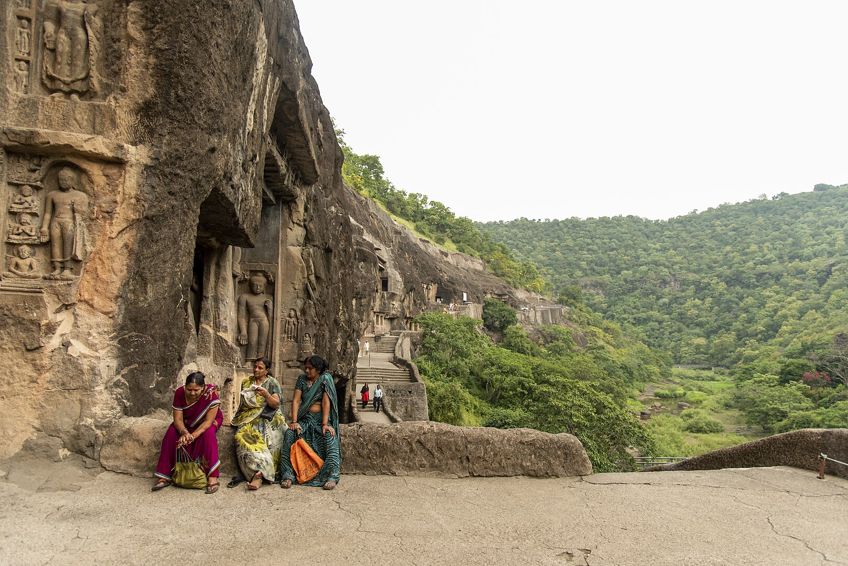
Two professors were brought in from Italy to undertake restoration efforts. However, these efforts would also ultimately prove fruitless after the Ajanta cave paintings began to deteriorate after the years of neglect following the restoration. Since being listed as a UNESCO World Heritage site in 1983, the Ajanta Caves have grown to become the region’s most popular tourist destination, with the thousands of visitors causing even further deterioration. Plans to create replicas of certain Ajanta cave murals at the complex’s entrance were put forward in 2012, in a bid to prevent any further damage from the heavy traffic normally experienced by these caves. These replicas would also allow visitors to view the works in the best light possible, as the original works were produced in extremely dimly-lit areas of the caves.
The Sites, Monasteries, and Worship Halls of the Ajanta Caves
The Ajanta caves were cut out of a cliff created by multiple volcanic eruptions near the end of the Cretaceous period. Because the rocks were horizontally layered and of varying quality, the artists had to change their carving methods and designs in certain sections. In the ensuing centuries, this variability of the rock quality has also caused cracks and collapses.

Sites
The sculptors most likely excavated the rocks as well as carved the exquisite designs of pillars, roofs, and idols. A grandiose entrance to the site was carved, featuring elephants on either side and a protective Naga god. The first-period caves appear to have been funded by a variety of distinct patrons in order to gain merit, with many inscriptions marking the contribution of particular pieces of a given cave. The latter caves were sponsored as a whole by a single patron among the local kings or court nobility, for merit in Buddhist afterlife doctrines.
Smaller shrines and statues were added between the caves by those wishing to attain merit once the main donor, Harisena, passed away.
Monasteries
Most of the caves are symmetrically square vihara halls. Smaller square dormitory chambers carved into the walls are connected to each vihara hall. In the second period, a shrine was erected at the back of each cave, centering on a massive figure of the Buddha, together with exquisitely sculpted reliefs and deities beside him, all sculpted out of the surrounding natural rock. The earlier viharas are considerably more basic and do not have shrines.

Worship Halls
The Worship Hall is another type of main hall architecture found at the Ajanta Caves with a smaller rectangular shape and high arched ceilings. The oldest of these worship halls were created in the 2nd to 1st centuries BCE, while the most recent ones were constructed in the late 5th century CE, and their design is similar to that of Christian churches, although without the crossing. Caves 9 and 10 from the early era and Caves 19 and 26 from the later period make up the four completed worship halls, and they all feature the same high ceilings with a nave leading to the stupa.
The stupa in two later halls is preceded by a massive relief sculpture of the Buddha.
The Ajanta Cave Paintings
The most prominent subject matter of the Ajanta cave murals is the visual narration of the Jataka tales. These tales document the various incarnations of the Buddha. These stories encompass ancient cultural lore and morals that can also be found in Jain and Hindu texts. Through his various incarnations in both human and animal form, the Buddha made specific sacrifices to attain enlightenment, and this is why the Jataka tales are regarded as so significant. Today, Ajanta cave murals created from both periods still exist.

Several pieces of Ajanta cave murals recovered from the older caves are essentially rare remnants of ancient Indian painting from this era and prove that by the Satavahana period, if not before, the Indian artists had perfected an effortless and fluid realistic style. Four of the newer caves include enormous and reasonably well-preserved Ajanta cave paintings that have come to characterize Indian mural painting to non-specialists, and also to reflect the finest achievements of not only Gupta-era art but of all Indian art. The Ajanta cave murals are the product of confident and adept artists, devoid of clichés and rich in content.
They are opulent, seductive, and glorify physical beauty, all of which early Western onlookers found starkly out of place in these chambers thought to be intended for prayer and disciplined monastic life.
All of the Ajanta cave paintings seem to be the product of artists who were supported by discerning connoisseurs and wealthy patrons. The art of painting was widely practiced and valued throughout the Gupta era, and unlike most Indian mural art, the compositions were not set out in horizontal bands but rather portrayed huge scenes radiating out from a single individual or group in the center.
Copies of the Ajanta Cave Paintings
Since their rediscovery, the artworks have deteriorated severely, and a number of 19th-century reproductions and sketches are required for a comprehensive understanding of the paintings. Several efforts to replicate the Ajanta cave murals for Japanese and European museums began in the 19th century, however several of these works were later lost in natural disasters and fires. The Royal Asiatic Society, for instance, commissioned Major Robert Gill, a painter and army officer, to produce reproductions of the artworks in the caves of Ajanta in 1846. Gill labored on his copies at the location for about two decades. He reproduced 27 big pieces of paintings, but all but four were lost in a fire at London’s Crystal Palace in 1866 when they were on exhibit.

He subsequently returned to the site and carried on creating copies until his passing in 1875. In 1872, the Bombay Presidency contracted John Griffiths to collaborate with his students to create reproductions of Ajanta cave paintings for export to England. They collaborated on this for 13 years and created over 300 paintings, many of which were presented at the Imperial Institute on Exhibition Road in London. However, another fire in 1885 damaged over 100 of the artworks stored in a part of the museum. A conservation attempt was started on nearly half of them in 2006, although Griffith and his pupils had coated several of the works with cheap varnish to make them easier to view, which has contributed to the degradation of the originals.
Lady Herringham and a team of Calcutta School of Art students, which included the future Indian Modernist artist Nandalal Bose, created a second series of reproductions between 1909 and 1911.
These replicas, more than the previous ones, attempted to fill in the gaps and damage to emulate the original condition instead of documenting the condition of the paintings as they existed after deteriorating for centuries. Another effort to reproduce the paintings was undertaken by the Japanese painter Arai Kamp, who was brought to India by Rabindranath Tagore to demonstrate Japanese painting methods. From 1916 to 1918, he worked on producing duplicates using tracings on Japanese paper, and his works were kept at Tokyo Imperial University until the archives were destroyed in the 1923 Great Kant earthquake.
Significance of the Caves of Ajanta Artworks
The Ajanta cave murals provide insight into the culture, lifestyle, and religion of India’s native inhabitants between the 2nd and 5th centuries BCE. Various researchers have analyzed them separately from the perspectives of history, gender studies, sociology, and South Asian anthropology. The clothing, jewels, gender relations, and social activities reflect the royal and elite lifestyle in some works, and in others, the attire of the ordinary man, rishi, and monks. The Ajanta cave paintings juxtapose the spiritual lifestyle of the monks who had given up all earthly belongings with the sensuous life of individuals who were labeled materialistic, opulent, emblems of money, and high fashion.

Many Ajanta cave murals depict images from markets, festivals, procession jesters, castles, and performing art stages. These wall paintings are similar in theme and detail to those discovered at Sanchi, Bharhut, Ellora, Amaravati, Badami, Aihole, and other Indian ancient sites. The Ajanta caves provide a visual and descriptive understanding of ancient Indian artistic traditions and culture, notably those relating to the Gupta Empire. The early colonial era characterization of the Ajanta caves was mostly orientalist and negative, contradicting Victorian expectations and stereotypes. The subjects and artworks of the Ajanta caves perplexed 19th-century Orientalists.
They couldn’t understand it because they lacked the Asian cultural legacy and framework that sees nothing strange in the combination of dancing girls and monks, as they had no knowledge of Jataka Tales or comparable Indian stories.
They inserted their own beliefs and preconceptions, labeling it something devoid of rationality and logic, a meaningless crude portrayal of aristocracy and foreigners infused with spirituality and sensuality. The impressions and conceptions of the Ajanta Caves in the 19th century were shaped by notions and preconceptions of the colonial mentality, and they only saw what they wanted to see.
The Depiction of Foreigners in the Ajanta Cave Paintings
The paintings in the Ajanta Caves are an important source of information about ancient India, particularly in regard to India’s relationships with other civilizations during the time most of the murals were created. The Ajanta cave paintings reflect Buddhism’s cosmopolitan nature, which welcomed individuals of various ethnicities, including Persian, Greek, Pahlavi, Saka, Kushan, and Huna. The murals are full of such foreigners, which has occasionally led to misinterpretations. The so-called “Persian Embassy Scene” appears in Cave 1 depicting figures with foreign facial features or clothing. A 19th-century architectural historian, James Fergusson, determined that this scenario corresponds to the Persian ambassador to the palace of the Hindu Chalukya monarch Pulakeshin II in 625 CE.
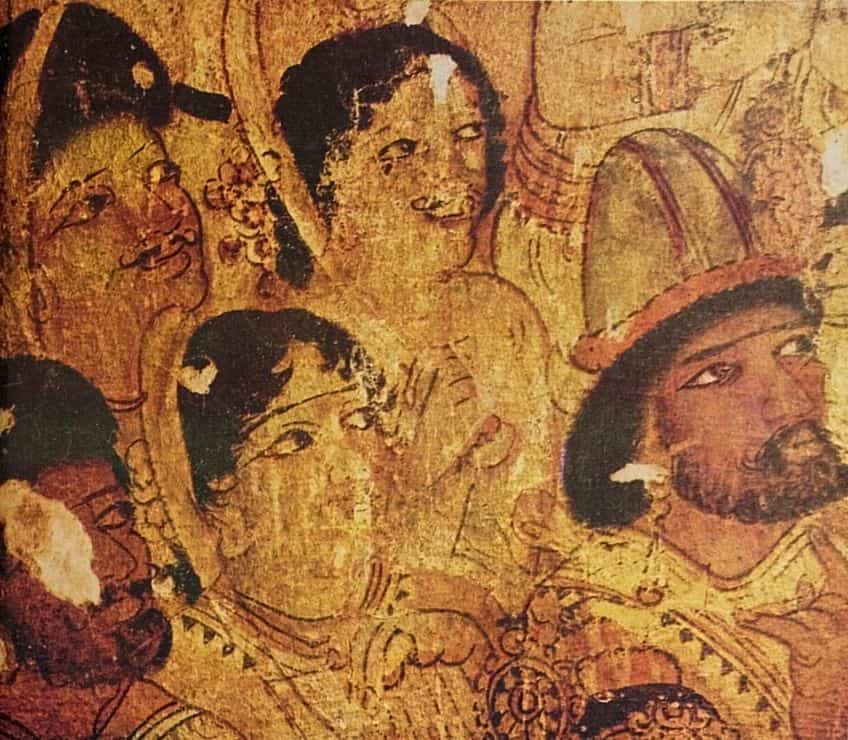
Another interpretation suggests that the mural depicts a Hindu diplomat visiting Persian king Khusrau II in approximately 625 CE. These hypotheses by colonial British era art historians were responsible for incorrectly dating this artwork to the 7th century, when in fact it represents a partially completed Harisena-era artwork of a Jataka tale with the depiction of trade between India and remote territories such as the Sassanian near East, which was frequent by the 5th century. Such murals depict a flourishing and cosmopolitan culture engaged in international trade in 5th-century India. The utilization of the blue lapis lazuli color to represent foreigners in the Ajanta murals, which must have been brought from Iran or Afghanistan, is further proof of international trade.
The Ajanta cave murals are regarded as some of the most significant ancient Indian artworks to still exist in the modern era. They were produced in two distinct phases, the second of which focused on the various incarnations of the Buddha. They were only discovered by the Western world in 1819 when a shepherd led a British officer to one of the cave entrances. Since then, there were multiple initiatives to preserve the Ajanta cave murals; however, many of them did nothing more than accelerate the rate of deterioration of these unique and ancient artworks.
Frequently Asked Questions
What Are the Ajanta Caves in India Known For?
The caves of Ajanta are renowned for their incredible paintings and sculptures. They are regarded as some of the finest examples of ancient Indian art that is still intact today. However, their general state has deteriorated over the centuries, despite efforts to preserve them. Many projects were undertaken to produce copies of the artworks so that they may be better understood. Replicas were also made in an attempt to lower the amount of traffic experienced in certain caves due to the murals’ popularity.
What Do the Ajanta Cave Murals Depict?
The caves were believed to have been created in two separate phases. In the first phase, most of the focus was placed on the stupa and there was no figurative depiction. The second phase focused on illustrating the story of Buddha’s various incarnations, and his journey of rebirth in various forms – both animal and human. Another interesting aspect of these works is the addition of foreigners. This has helped to reveal much information about the cultural and trading interactions that occurred between the inhabitants of the region and outsiders. Without the necessary cultural context and understanding, however, colonialists have largely misinterpreted the meanings of these paintings.
Justin van Huyssteen is a freelance writer, novelist, and academic originally from Cape Town, South Africa. At present, he has a bachelor’s degree in English and literary theory and an honor’s degree in literary theory. He is currently working towards his master’s degree in literary theory with a focus on animal studies, critical theory, and semiotics within literature. As a novelist and freelancer, he often writes under the pen name L.C. Lupus.
Justin’s preferred literary movements include modern and postmodern literature with literary fiction and genre fiction like sci-fi, post-apocalyptic, and horror being of particular interest. His academia extends to his interest in prose and narratology. He enjoys analyzing a variety of mediums through a literary lens, such as graphic novels, film, and video games.
Justin is working for artincontext.org as an author and content writer since 2022. He is responsible for all blog posts about architecture, literature and poetry.
Learn more about Justin van Huyssteen and the Art in Context Team.
Cite this Article
Justin, van Huyssteen, “Ajanta Caves – A Look at the Paintings in the Caves of Ajanta.” Art in Context. June 23, 2023. URL: https://artincontext.org/ajanta-caves/
van Huyssteen, J. (2023, 23 June). Ajanta Caves – A Look at the Paintings in the Caves of Ajanta. Art in Context. https://artincontext.org/ajanta-caves/
van Huyssteen, Justin. “Ajanta Caves – A Look at the Paintings in the Caves of Ajanta.” Art in Context, June 23, 2023. https://artincontext.org/ajanta-caves/.



